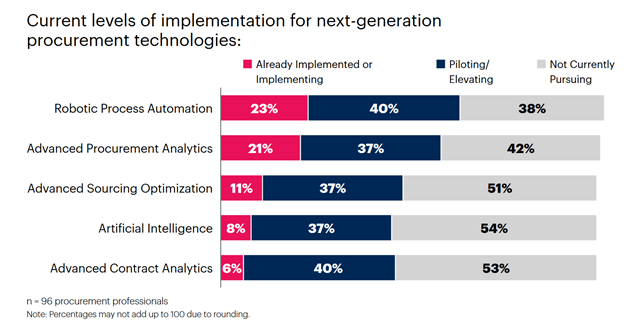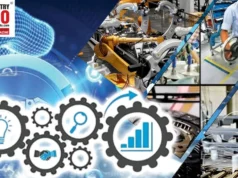Unlocking Cognitive Procurement: Transforming
Procurement Processes with AI
Procurement is one of the most technologically under-invested functions in a company. As per a recent Gartner survey (https://www.gartner.com/en/supply-chain/trends/investment-in-procurement-technologies), more than 50% of procurement organizations do not have an advanced sourcing optimization, AI or advanced control analytics strategy. Approximately 40% are not exploring advanced procurement analytics or robotic process automation (RPA). The top 2 reasons are the lack of high-quality data and lack of in-depth data analysis skills.

Source: (https://www.gartner.com/en/supply-chain/trends/investment-in-procurement-technologies)
However, leveraging AI innovations, particularly in generative AI through large language models, can empower procurement professionals to realize the vision of Cognitive Procurement. Here are a few practical areas where AI can be implemented to drive immediate benefits in procurement processes.
1. Generate a category strategy:
AI engines can assist procurement professionals in creating the initial draft of a category strategy. By inputting business objectives, product portfolio, pricing strategy, and marketing budget, the AI model can provide a first cut pricing strategy. Additional data sources such as competitor and supplier performance, channel data, etc., can enrich the analysis, enabling a more nuanced strategy. This AI-powered approach also aids in developing procurement plans for new market entries or product launches, predicting market prices, identifying potential vendors, and assessing existing suppliers.
2. Supplier discovery & risk management:
AI engines can monitor global and local developments, alerting procurement teams to potential supplier risks that could impact production timelines, quality, or cost. Alerts related to changes in taxation policies, raw material prices, currency fluctuations, legal issues, or social media activism can be used to highlight supplier risk & enhance supplier risk scores. This enables proactive assessment of the impact on production ]cost, timelines & quality allowing production teams to take timely corrective action.
3. Automation:
AI can automate various procurement activities, reducing the burden of manual tasks. Activities like vendor shortlisting, RFP creation, RFP evaluation, contract negotiation, contract creation etc. take an enormous amount of time. AI driven guided buying can automate the whole buying process to a large extent with human oversight.
As an example, business can provide the design schematics to the AI engine which can do a reverse look up to identify the accurate part numbers & specs. The historical purchasing data is automatically analyzed to create a shortlist of potential suppliers & the key contract terms.
On the supplier side, I have seen many organizations which employ teams of specialists to just convert business specs for say an oil drilling equipment to a Bill of Material (BOM), configure it and create a quotation. They also need to keep in mind the competition pricing & delivery timelines, historical win rates in different markets (tribal or market knowledge in other words), probability of winning in the other bids concurrently running etc. while creating the price. Added to this, are the endless approval reports with win probability, risk scores etc. that need to be generated for each bid. This entire process can be automated by an AI engine using the historical win data, pricing information, copies of earlier RFP responses & contracts etc. This will allow the procurement experts to focus more on the procurement strategy and building domain skills than on routine manual activities.
4. Supplier selection:
AI engines can recommend the best negotiation scenario, including the agenda, sequence of points to be negotiated, arguments to be used, expected counterarguments, suggested discussion tactics, and in consequence the Most Desirable Outcome (MDO), Least Acceptable Agreement (LAA), and Best Alternative to Negotiated Agreement (BATNA). This can help category managers negotiate more effectively and achieve better outcomes.
5. Sourcing review:
AI engines can analyze supplier contracts and performance data to identify sourcing issues such as uncompetitive payment terms, duplicate suppliers, bad purchases, maverick spending, and invoice fraud. This process, which would traditionally require several hours of manual analysis, can be automated and standardized, saving significant time and effort.
Spend classification:
Enterprise ERPs are constantly becoming better at classifying spend data. However, this remains a big area of concern for CPOs. AI assists in easily analyzing and classifying spend data through intuitive chat interfaces. It helps uncover maverick spending to increase sourcing through preferred vendors.
ESG & Green-sourcing:
Recent research reports indicate that ESG is fast becoming a top priority for CPOs. In a recent Deloitte procurement survey (https://www2.deloitte.com/content/dam/Deloitte/us/Documents/consulting/us-2023-global-chief-procurement-officer-survey.pdf), ESG featured as the number 2 priority for CPOs, while it was number 7 on the priority list in 2021.
Procurement professionals will struggle with manual analysis of ESG compliance of their suppliers & find better alternatives. AI can analyze supplier data, both internal and external, to assess ESG compliance. By evaluating emissions, water usage efficiency, labor practices, and diversity, AI engines can suggest greener supplier alternatives and benchmark them on performance metrics. This enables procurement professionals to make sustainable sourcing decisions aligned with their organization’s ESG goals.
AI has the potential to transform procurement teams by making them more efficient, analytical & forward looking. Through AI-powered tools and techniques, procurement professionals can simplify operational tasks, reduce supplier risks, and make better sourcing decisions.
Disclaimer: The views expressed here are my own and do not necessarily reflect the views of my organization.
About the Author :
 Mr. Umang Varma
Mr. Umang Varma
Oracle
Mr. Umang Varma is an Innovation Advisor with expertise in AI, Web3, Industry 4.0, IOT, Blockchain & cloud technologies.
Mr. Umang Varma is a LinkedIn Top Voice in Business Intelligence ( BI ).
Mr. Umang Varma has more than 20 years of experience in driving large technology-led transformations in global organizations.
Mr. Umang Varma passion is in using emerging technologies like Big Data,
Blockchain, IoT & AI to drive business outcomes.
Mr. Umang Varma currently leads a team of cloud architects for Oracle
and is based in Malaysia.
Mr. Umang Varma writes article on emerging tech and some of his articles
have been featured by industry associations.
Outside work, Mr. Umang Varma enjoys speedcubing & scuba diving.
Mr. Umang Varma is Bestowed with the following Licences & Certifications :
https://www.linkedin.com/in/um
Mr. Umang Varma can be contacted at :











